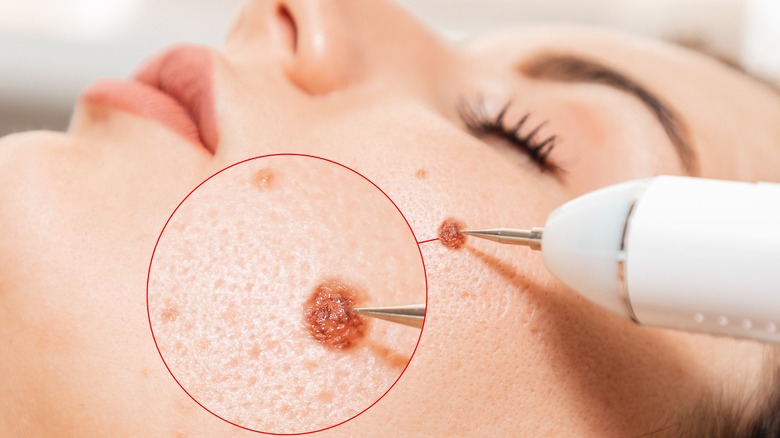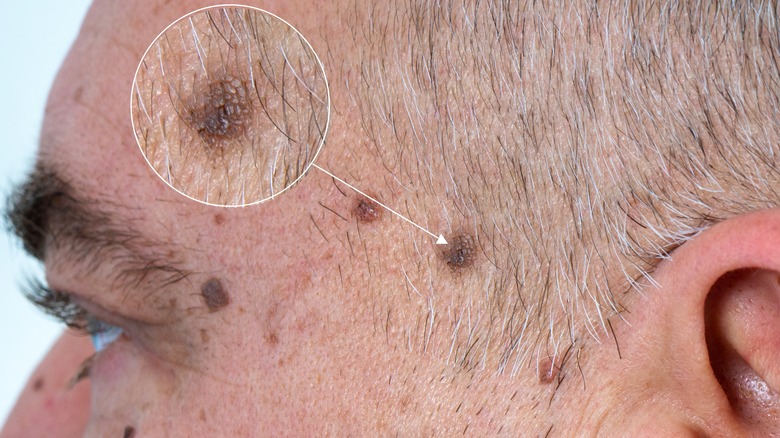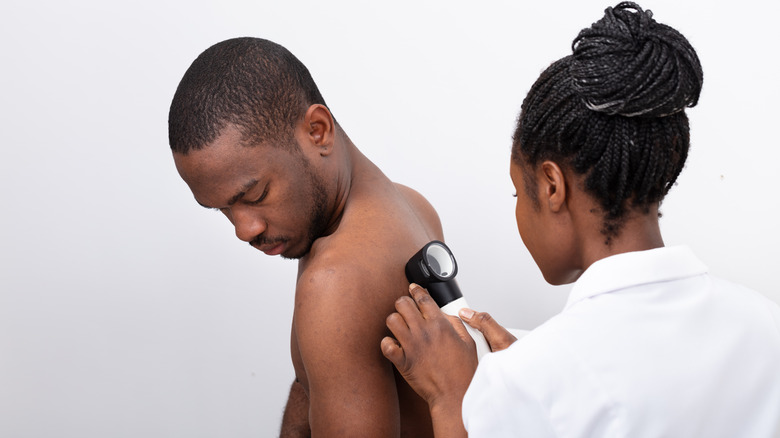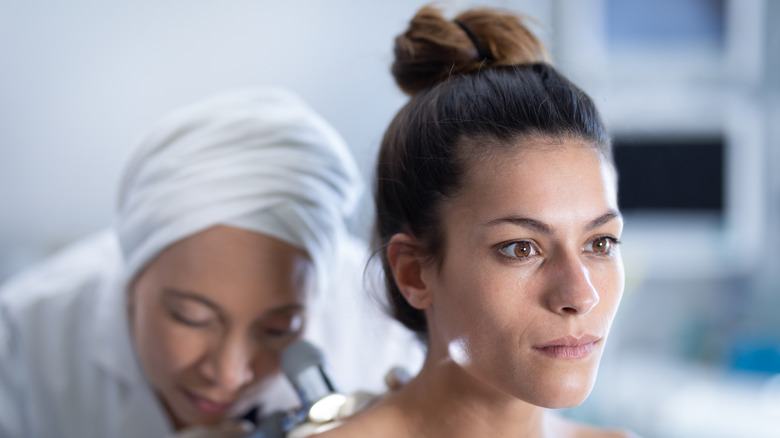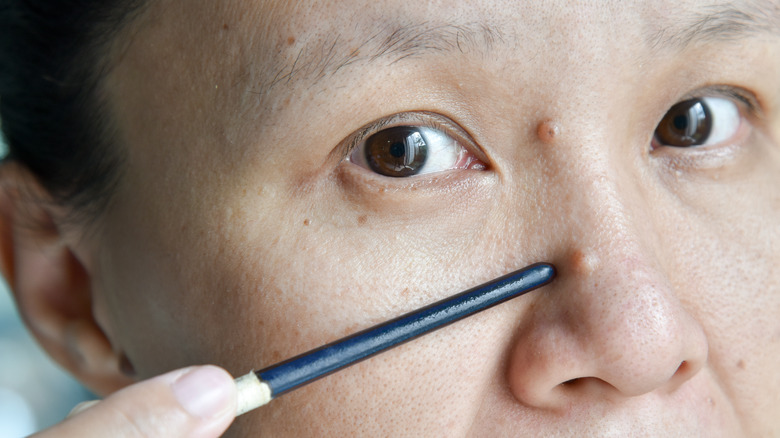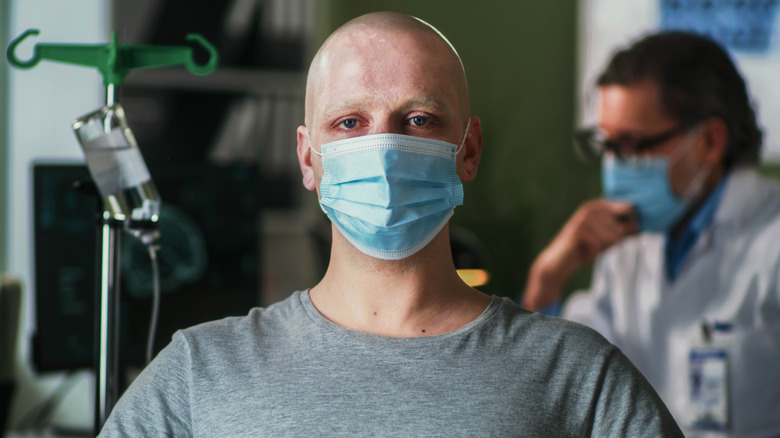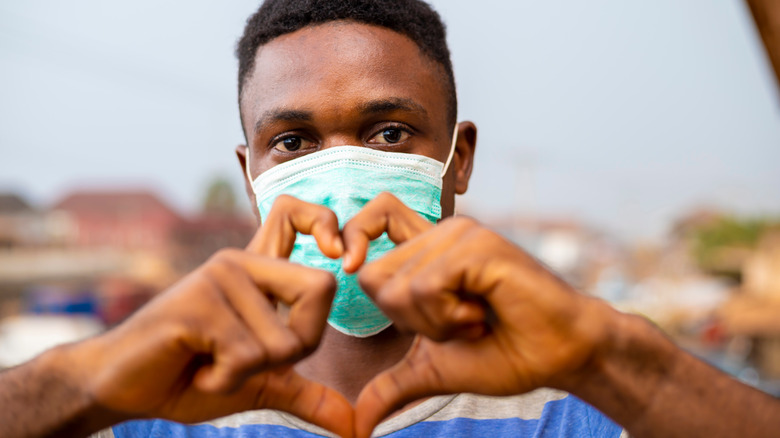Everything You Wanted To Know About Melanoma
Considering melanoma is a less common type of cancer than prostate cancer, colorectal cancer, breast cancer, and lung and bronchus cancer, that it's the most life-threatening skin cancer is cause for concern. Compared to all the people who get cancer for the first time in the United States, melanoma's found to take about 5% of that population. And looking at the trend of the condition from 1992 through 2019, you'll realize there's been an upward trend of newly registered cases over the years. In fact, in 2022 alone, the expected number of new cases is a little under 100,000. These statistics show that many of us aren't taking the proper precautions (via the National Cancer Institute).
Keep in mind, almost 8,000 people may die from the condition in 2022, according to the report by the National Cancer Institute. And while some of them may be well-advanced in age, we may lose even people as youthful as those in their 20s (per American Cancer Society). These may be our sons and daughters and it may be heartbreaking to realize, later on, that we could have done something to prevent them from developing it or having it claim their lives. Getting the right information about melanoma in terms of the causes, prevention and management can go a long way — and through this exhaustive guide on the condition, we aim to provide you with everything you want to know about melanoma so you can save your life and those of your loved ones.
What brings about melanoma
The Mayo Clinic explains that what specifically brings melanoma isn't well-known, although laying your skin open to ultraviolet (UV) radiation for lengthy periods is one of the major contributors. This means that if you're basking in the sun a lot and using sunbathing beds or even tanning beds, you're increasing your risk. The ultraviolet radiation affects the DNA in your skin cells, which then results in most types of skin cancer — including melanoma. Ideally, three main categories of ultraviolet light exist: ultraviolet A, ultraviolet B, and ultraviolet C (via the National Health Service).
Ultraviolet A and B normally target fair-skinned people and increases their chances of developing skin cancer as they get more and more exposure. While it's still unclear if ultraviolet A contributes heavily toward melanoma, ultraviolet B has a reputation for being the biggest contributor to all skin cancers. Ultraviolet C has the most damaging effect on the skin although the atmosphere keeps it from reaching your skin.
Moles are also another likely cause of melanoma. Having irregular-shaped moles with an average size of above 5 millimeters — on your skin — may end up developing melanoma in the long run. The American Cancer Society notes that moles convert to melanoma, although not all of them. Many mole cells may experience alterations in their genes and end up evolving into melanoma cells. However, the actual reason for this evolution in some, and not all, mole cells remains a mystery.
More risk factors
Apart from ultraviolet radiation and moles, another factor that brings you close to developing melanoma is the color of your hair, skin, and eyes. People whose eyes are green, blue, or another bright color, or hair that's red or blonde, or with light skin have a higher likelihood of getting melanoma (per American Cancer Society). The Memorial Sloan Kettering Cancer Center traces the physical features' origin to melanin, which defines the pigmentation of your eyes, hair, and skin. Those with lighter skin tone tend to have little melanin hence their pale skin color while those whose skin has more melanin tend to have darker skin and more protection — because melanin plays a protective role for the epidermal cells' DNA.
The ultraviolet B radiation goes through your skin into the cells, gets to the DNA, and causes it harm. With time, the damage may lead to skin cancer. Melanocytes cells — cells located in the lower level of the epidermis — produce melanin which absorbs the ultraviolet B radiation and prevents DNA damage and the occurrence of skin cancer. So those who have bright-colored eyes, hair, and skin are more susceptible to ultraviolet radiation as they have low quantities of the protective melanin. (via Skin Cancer).
Other factors that pave the way for melanoma include having had skin cancer a few years ago, if you've gotten sunburned or undergone radiotherapy in the recent past, having a family member with a history of melanoma, and having chronic illnesses — diabetes, for example — or using medications that weaken your immune system (per the National Health Service).
Worrisome signs and symptoms
Cancer Research UK advises you to seek immediate medical attention when you observe a new mole on your body or when the mole you've always had begins changing in terms of shape, color, and size. A common and handy checklist for checking the indicators of melanoma for both doctors and potential patients — called the ABCDE signs of melanoma — can help you understand if you have it.
The A represents asymmetry. Most often, melanoma moles come in irregular shapes, and if you visually draw a line that divides the mole into two, and one half differs in size from the other, that may indicate melanoma. The B represents border. If there's inconsistency in the mole's border, that may also signal melanoma. The C represents color. Melanoma comes with "uneven color and contain more than one shade." The D represents diameter. If the mole's diameter is beyond 6 millimeters, that's a cause for worry. The E represents evolving. Melanoma moles evolve in terms of shape, color, and size — if the moles on your body are behaving the same, you should contact your doctor immediately.
Since melanoma expresses itself uniquely in different people, if you also take note of something that appears to be a brown or pinkish sore, a solid and smooth-looking growth, an age spot, a bruise, a cyst, a black spot, or a straight line from the bottom of a nail to tip of the nail, get a diagnosis as it may be melanoma too (via the American Academy of Dermatology Association).
Concealed melanomas
HealthCentral points out that melanoma may not always give off signs it's there in places your eyes can reach. In other words, it may hide itself where you may not even care to look, and these types of hidden melanomas tend to get discovered when in life-threatening stages. Sometimes, people may mistake them to be hemorrhoids, so it's always important to do thorough skin checks. Some known hidden places for melanoma include your legs, soles of your feet, back, abdomen, eyes, fingernails, below your penis' foreskin (if uncircumcised), under your hair (on the skin covering your head), or between your toes.
Franciscan Health also explains the area around your ears, between your buttocks, and that small section that separates the border of your ears with your hairline may be other possible locations. But that's not enough, moles can show up in other unexpected areas beyond the mentioned ones. For instance, Melissa Albin said she didn't know a mole existed around the area surrounding the tricep until a stranger told her about it. She explained to Today in an interview, "Finally she [the stranger] came up to me and she said, 'I'm really sorry if this is weird, but I've been looking at the mole on the back of your arm and I'm wondering if you ever had it checked out ... I'm a dermatologist and it's very concerning to me. I think you need to go get it checked as soon as possible.”' Albin's doctor said the stranger was a savior, because it was melanoma but caught early.
Getting diagnosed
Melanoma diagnosis may happen differently for everyone based on individual risk factors. However, there are some similarities, too. Ideally, your doctor will perform a biopsy (where a small tissue sample of the mole gets taken from your body for analysis). After that, further testing may follow based on the outcome (per the American Society of Clinical Oncology).
According to the American Cancer Society, several types of skin biopsies exist: punch biopsy (that takes circular-shaped tissue samples), shave biopsy (mostly used where melanoma is highly likely and involves shaving your skin), optical biopsies (which involve biopsies that don't require extracting a tissue sample), sentinel lymph node biopsy (which helps to determine if the melanoma has gotten to your lymph nodes), surgical lymph node biopsy (a surgery-based biopsy that takes out the lymph node), and fine needle aspiration biopsy (which uses a needle, that's tinier than that for blood tests, and retrieves tiny chunks of the tumor or lymph nodes).
Going by the American Society of Clinical Oncology, other tests done during melanoma diagnosis include ultrasounds (for a clear visualization of the organs and how the tumor looks and how it's spreading), Magnetic Resonance Imaging (MRI), which is a test with magnetic fields to determine how big the tumor is, computed tomography (CT), a test that works with x-rays to take 3D images that show the tumors or irregularities in your body, and positron emission tomography (PET-CT), a scan that normally works together with the CT scan and uses a sugary element that's radioactive to get clear images of your body's tissues and organs.
The different stages of melanoma
After the diagnosis reveals the type of melanoma, the doctor seeks to determine the stages. Several types of melanoma exist: eye melanoma (which occurs in the eyes), nodular melanoma (which expresses itself as a strong and steady node on top of your skin), acral lentiginous melanoma (often affects your fingernails, soles of the feet, palms, and toenails), superficial spreading melanoma (which initially affects your skin's upper section and slowly gets underneath the skin's surface), lentigo maligna melanoma (commonly found on the neck, face, and scalp). Other subtypes of the condition like nevoid melanoma, desmoplastic melanoma, amelanotic melanoma, and spitzoid melanoma also exist (via the Memorial Sloan Kettering Cancer Center).
As for staging, melanoma falls under five stages: stage zero, stage one, stage two, stage three, and stage four. In stage zero, some melanocyte cells become cancerous. In this stage, the spread can be easily controlled and treated. In stage one, the melanoma digs more into your skin, although there's no spread to other organs. In stage two, it's still contained but the tumor is bigger and sometimes with visible ulcers on it. In stage three, it begins to spread, and the first destination is the lymph nodes. When it gets to stage four, the tumor has spread beyond the lymph nodes to nearby organs like the lungs and liver (per Cancer Treatment Centers of America).
Treating melanoma with surgery
After the staging process, your doctor will recommend you get immediate treatment so you can control and treat the melanoma. In many cases, surgery is the go-to treatment for this cancer. Some surgical options your doctor may use in your case include wide excision, Mohs micrographic surgery, amputation, and lymph node dissection. Wide excision gets rid of the tumor entirely by first numbing it with local anesthesia and then cutting it off along with the skin next to it. The reason why the nearby unaffected skin is also taken away is to ensure no cancer remains in that area (via the American Cancer Society).
Mohs micrographic surgery works with a layer-by-layer removal approach. With every lightweight skin layer that's cut and cancer is present, the doctor proceeds to cut another lightweight skin layer until they no longer see the cancer. In amputation, the doctor seeks to eliminate the entire affected body organ like a finger, if it's affected beyond repair. In lymph node dissection, the surgeon aims to take away the lymph nodes close to where the initial tumor is, as that's the first destination for the cancer when it begins spreading.
The Memorial Sloan Kettering Cancer Center also mentions plastic and reconstruction surgery for melanoma cases that affect the face and other tiny melanomas. After completing this procedure, your surgeon may let the natural wound-healing process take its course. At times, they may use tissue from another body part and use it to close the wound. In other cases, they may use soluble stitches or a donor's tissue.
Non-surgical interventions
While surgery appears to be efficient in dealing with melanoma and other skin cancer types, non-surgical treatment options may also prove useful in some cases. For instance, cryotherapy (often referred to as cryosurgery) is a therapeutic treatment that can help with neck and head melanomas, especially for sensitive areas in serious cases. The treatment showed effective results on a 101-year-old lady who had melanoma on her right side of the face. In 90 days, she was able to receive treatment which worked perfectly without any problems even two years later. In her case, the treatment's first section involved using a cryoprobe — a medical tool used to make your body tissues freeze — with liquid nitrogen on the affected area. In the second phase, the medical experts used nitrous protoxide as replacement for liquid nitrogen (per In Vivo Journal).
Technology in Cancer Research & Treatment lists other common non-surgical options for melanoma that include chemotherapy (which uses medications like temozolomide and dacarbazine to prevent the growth and multiplication of the cancer cells), radiotherapy (high-power radiation used to wipe out cancer cells), and biological therapy (which works with medication that make your immune system stronger and more powerful to deal with the cancer cells).
Surviving melanoma
Fighting melanoma is possible and you can go from having only a few years to live to beating the timeline and reducing the size and spread of the tumor. One of the people who've managed to do it is Tim Grimes. After confirming melanoma stage four in 2014, he confesses his world crumbled. The cancer had gotten to his lymph nodes, liver, spine, and lungs. Later on, it got to the brain and began increasing in size. Sharing his story with The University of Kansas Cancer Center, he says, "I was told I had between 12 and 18 months to live. I had only a 5% chance to live longer than that." However, after going through radiation therapy, the tumor's size in the brain reduced by 50%.
The American Cancer Society notes that people who survive melanoma should remain under the keen eye of the doctor and should go for follow-ups (which may involve tests and further examinations) so they can keep the condition away and make it less likely to come back. A survivorship care plan for melanoma survivors can really help them know when to go for follow-ups, which food and fitness exercises to work with, recommended future screening tests, what to expect from the treatment, and how to handle negative effects from the treatment.
Coping with melanoma
One of the biggest ways cancer diagnosis affects you is emotionally. It's easy to lose control of your emotions and feel mentally overwhelmed when you get full confirmation of melanoma's existence in your body. However, this should not be the end of the road for you. You can take back control of things by sharing your thoughts and feelings with other people — close friends, family members, and relatives. They can give you comfort, assurance, and strength that you can overcome the condition. Secondly, look for groups of people with melanoma (online or offline) as that can also prove to be helpful. People in these groups share the same concerns you have and you can relate with each other on a deeper level than you may with friends or relatives (via WebMD).
The American Society of Clinical Oncology also recommends being open with your supportive care team that your health center provides, sharing the treatment's side effects with your doctor, and following the doctor's instructions on minimizing them. You're also advised to talk to the attendant who deals with finance in your clinic to discuss financial assistance with your treatment if you need it. Several options may be available and can help ease the financial stress. Moreover, if you're the one caring for someone with melanoma, ensure you help as much as you can in terms of medication, house duties, emotional support, food, and going for doctor's appointments — these arrangements can save them a lot of hassles.
Melanoma prevention
Let's be honest, it can be hard for everyone to prevent melanoma. Some factors, like the condition running in your genes, are beyond your power. However, for those that are within your handle (think: sun exposure) you can keep in mind a few useful tips to bring down the risk. The Skin Cancer Foundation recommends examining your full-body monthly, avoiding the sun between late mornings to early evenings, keeping away from tanning beds, and getting sunglasses and wide hats that prevent ultraviolet rays from penetrating your eyes and skin.
Additionally, if you are an outdoor person and take your kids along, ensure you apply sunscreen on the kids if they are six months old and above. For your precaution, consider spreading an ounce of sunscreen that has a Sun Protection Factor (SPF) above 15 every time you head out. And if you'll be outside for a long time, go for an all-inclusive sunscreen with more than 30 in SPF.
The American Cancer Society adds that you should maintain a well-functioning immune system by keeping away from infections like HIV and AIDS that affect it. However, people who are on chemotherapy, those who have autoimmune diseases, and those who had some of their organs transplanted — who may have their immune system impacted by their treatment — should keep pursuing the treatment despite the risk, as it's lower than the side effects of avoiding treatment altogether.

